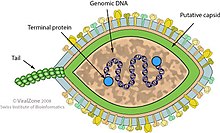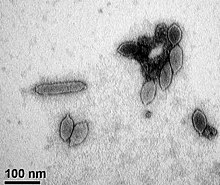Halspiviridae
| Salterprovirus His1 | |
|---|---|

| |
| Diagram of virion structure | |

| |
| Transmission electron micrograph of virions, negatively stained with uranyl acetate. Scale bar = 100 nm. | |
| Virus classification | |
| (unranked): | Virus |
| Realm: | incertae sedis |
| Kingdom: | incertae sedis |
| Phylum: | incertae sedis |
| Class: | incertae sedis |
| Order: | incertae sedis |
| Family: | Halspiviridae |
| Genus: | Salterprovirus |
| Species: | Salterprovirus His1
|
 | |
| Locality of isolation: saltern crystalliser in Avalon, Victoria, Australia | |
| Synonyms | |
| |
Halspiviridae is a family of viruses that consists of a single genus, Salterprovirus, which consists of a single recognised species; Salterprovirus His1 (hereafter, 'His1'). This virus was isolated from hypersaline water in Australia and was able to be cultured on the halophilic archaeon Haloarcula hispanica. Like many other archaeoviruses, His1 has an approximately limoniform (lemon-shaped) virion.[1][2][3][4]
Etymology[]
The family name, Halspiviridae, is derived from halophilic and spindle-shaped, in reference to the habitat and virion morphology, respectively. The genus name, Salterprovirus, is derived from salty terminal protein virus, as the linear dsDNA genome has proteins attached to the 5′ termini.[1]
Taxonomy[]
The virion has a spindle-shaped morphology and is similar in shape to that of viruses infecting thermophilic archaea, the Fuselloviridae, and His1 was originally described as a probable member of that group.[1] However, it was later found that there is no genetic relationship and their replication strategies are entirely different, and so His1 was classified into a new group, genus Salterprovirus within the family Halspiviridae.[5] Halspiviridae has not been classified within any higher-ranked taxa.
Environmental DNA sequences derived from Namib salt pans indicate the presence of currently unrecognised, distant relatives of His1.[6]
Another species of virus, now named (hereafter 'His2'), was originally considered to be related to His1,[2][3] but later analysis of the His2 virion revealed that this species actually belongs to the family Pleolipoviridae.[7]
Structure[]
The virus is enveloped, with limoniform or spindle-shaped morphology. Genomes are linear, around 14.5kb in length. The genome has 35 open reading frames.[3] A negatively stained electron microscope (EM) picture of His1 virions is shown on the right of this page. There is some variation in particle length (e.g. example seen left of centre), but most display the typical limoniform capsid with a short tail. High resolution micrographs and cryoEM reconstructions have been published by Hong et al. (2015),[8] who gave average dimensions of 92 x 40 nm with a 12 nm tail.
| Structure | Capsid | Genomic arrangement | Genomic segmentation |
|---|---|---|---|
| Limoniform | Protein | Linear | Monopartite |
Replication cycle[]
Viral replication is cytoplasmic. Entry into the host cell is achieved by virus attachment to the host cell. An adsorption rate constant for His1 of 1.9 x 10−12 ml min−1 has been experimentally determined by Pietilä et al. (2013).[9] DNA-templated transcription is the method of transcription. Haloarcula hispanica may serve as a host. Transmission occurs via passive diffusion.[3]
| Host details | Tissue tropism | Entry details | Release details | Replication site | Assembly site | Transmission |
|---|---|---|---|---|---|---|
| Archea: Haloarcula hispanica | None | Injection | Lytic | Cytoplasm | Cytoplasm | Passive diffusion |
Genome[]
| NCBI genome ID | NC_007914 |
|---|---|
| Genome size | 14,464 nucleotides |
| Year of completion | 2020 |
The linear, dsDNA genome of His1 consists of 14,464 base-pairs (bp), has imperfect inverted terminal repeat sequences of 105 bp, and is annotated to carry 35 protein coding genes, including a gene specifying a protein-primed DNA polymerase (B-family). The ends of the genome have a protein attached.[2] The protein sequence of the polymerase is 42% identical to the polymerase specified by the gammapleolipovirus His2, even though the two viruses belong to very different taxonomic groups.
References[]
- ^ a b c Bath C, Dyall-Smith ML (November 1998). "His1, an archaeal virus of the Fuselloviridae family that infects Haloarcula hispanica". Journal of Virology. 72 (11): 9392–5. doi:10.1128/JVI.72.11.9392-9395.1998. PMC 110367. PMID 9765495.
- ^ a b c Bath C, Cukalac T, Porter K, Dyall-Smith ML (June 2006). "His1 and His2 are distantly related, spindle-shaped haloviruses belonging to the novel virus group, Salterprovirus". Virology. 350 (1): 228–39. doi:10.1016/j.virol.2006.02.005. PMID 16530800.
- ^ a b c d "Viral Zone". ExPASy. Retrieved 15 June 2015.
- ^ ICTV. "Virus Taxonomy: 2014 Release". Retrieved 15 June 2015.
- ^ Adriaenssens EM, Sullivan MB, Knezevic P, van Zyl LJ, Sarkar BL, Dutilh BE, et al. (May 2020). "Taxonomy of prokaryotic viruses: 2018-2019 update from the ICTV Bacterial and Archaeal Viruses Subcommittee". Archives of Virology. 165 (5): 1253–1260. doi:10.1007/s00705-020-04577-8. PMID 32162068.
- ^ Adriaenssens EM, van Zyl LJ, Cowan DA, Trindade MI (January 2016). "Metaviromics of Namib Desert Salt Pans: A Novel Lineage of Haloarchaeal Salterproviruses and a Rich Source of ssDNA Viruses". Viruses. 8 (1): 14. doi:10.3390/v8010014. PMC 4728574. PMID 26761024.
- ^ Bamford DH, Pietilä MK, Roine E, Atanasova NS, Dienstbier A, Oksanen HM (December 2017). "ICTV Virus Taxonomy Profile: Pleolipoviridae". The Journal of General Virology. 98 (12): 2916–2917. doi:10.1099/jgv.0.000972. PMC 5882103. PMID 29125455.
- ^ Hong C, Pietilä MK, Fu CJ, Schmid MF, Bamford DH, Chiu W (February 2015). "Lemon-shaped halo archaeal virus His1 with uniform tail but variable capsid structure". Proceedings of the National Academy of Sciences of the United States of America. 112 (8): 2449–54. Bibcode:2015PNAS..112.2449H. doi:10.1073/pnas.1425008112. PMC 4345568. PMID 25675521.
- ^ Pietilä MK, Atanasova NS, Oksanen HM, Bamford DH (June 2013). "Modified coat protein forms the flexible spindle-shaped virion of haloarchaeal virus His1". Environmental Microbiology. 15 (6): 1674–86. doi:10.1111/1462-2920.12030. PMID 23163639.
External links[]
| Wikimedia Commons has media related to Salterprovirus. |
- Double-stranded DNA viruses
- Virus genera
- Virus families